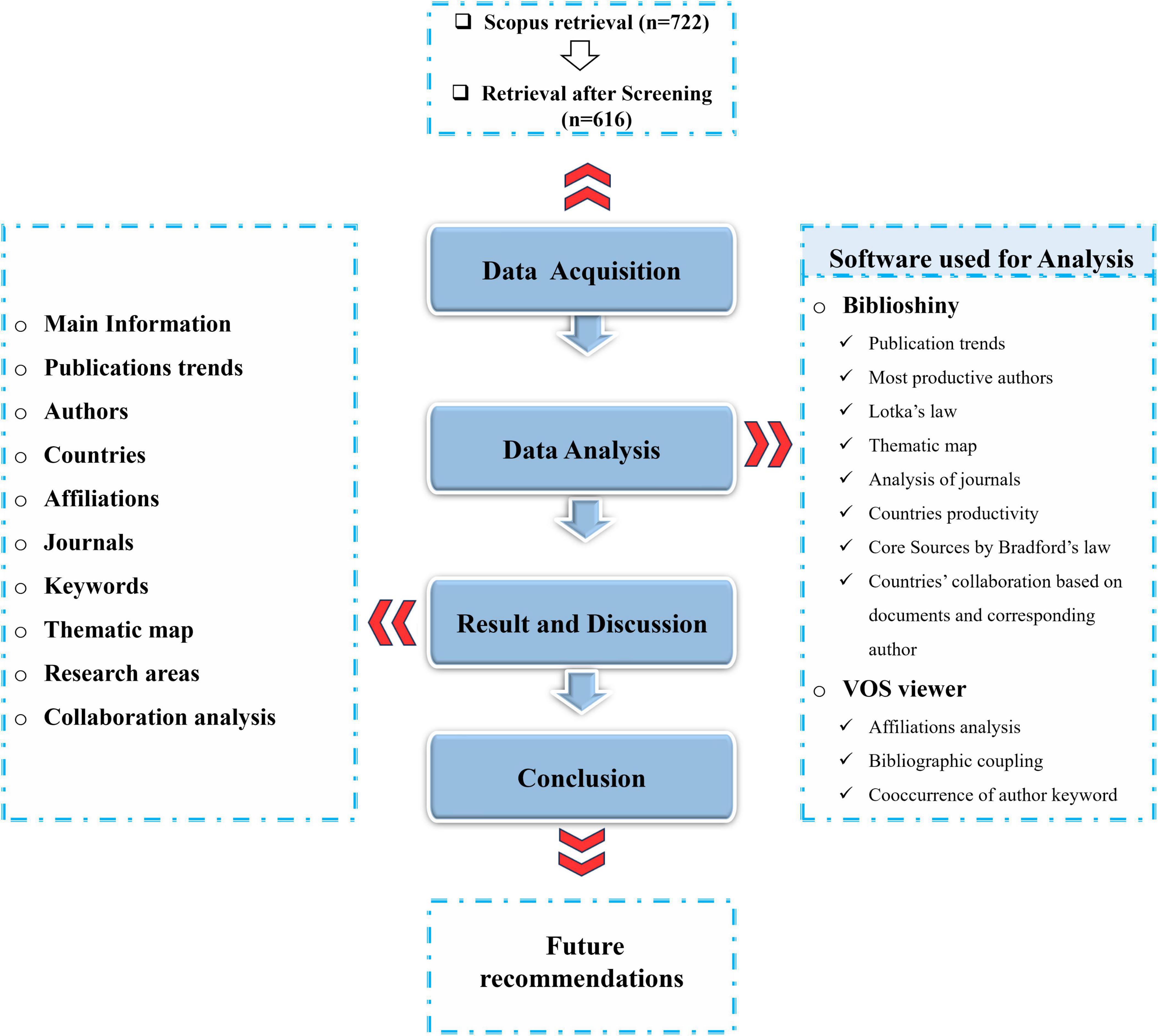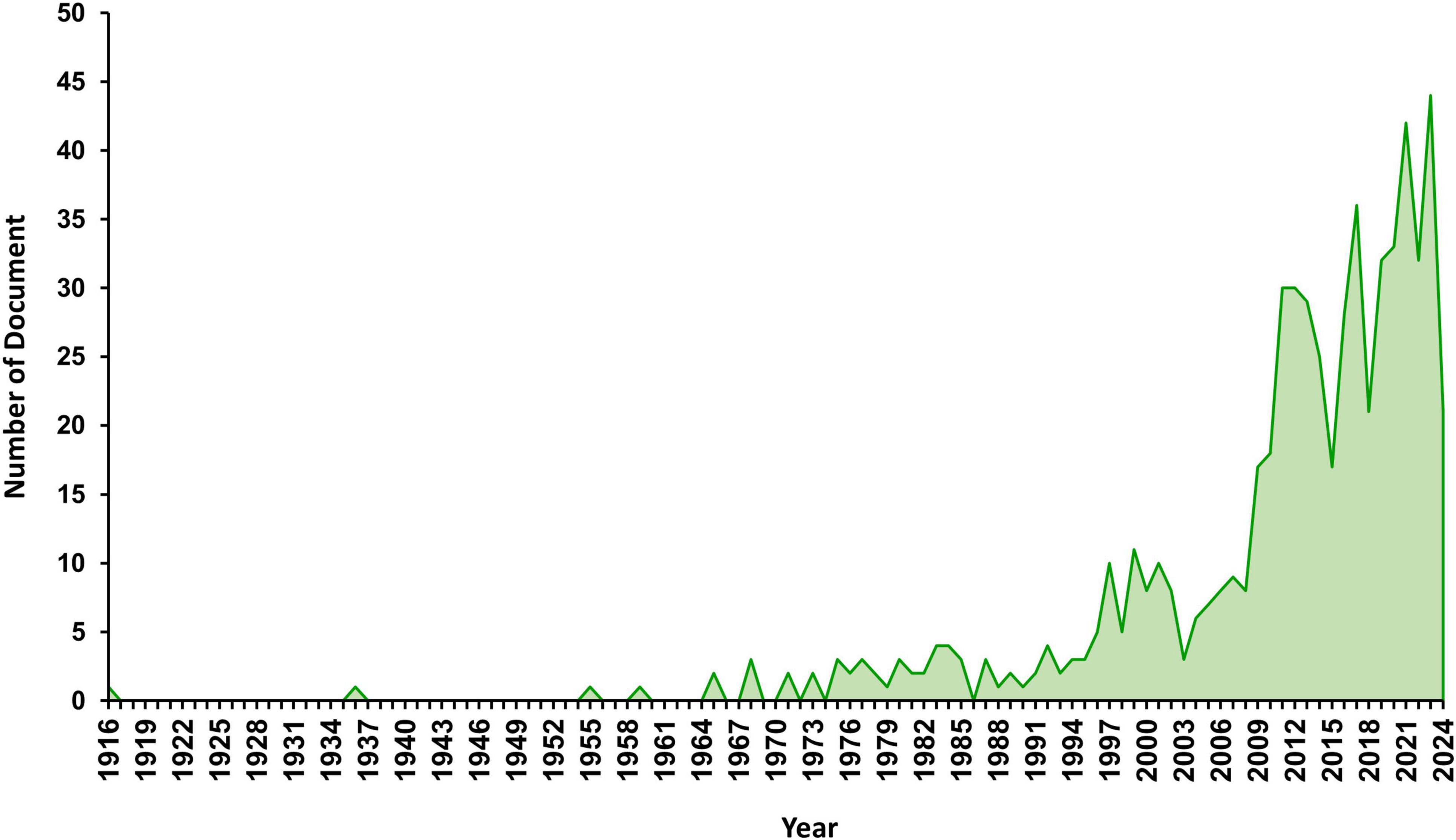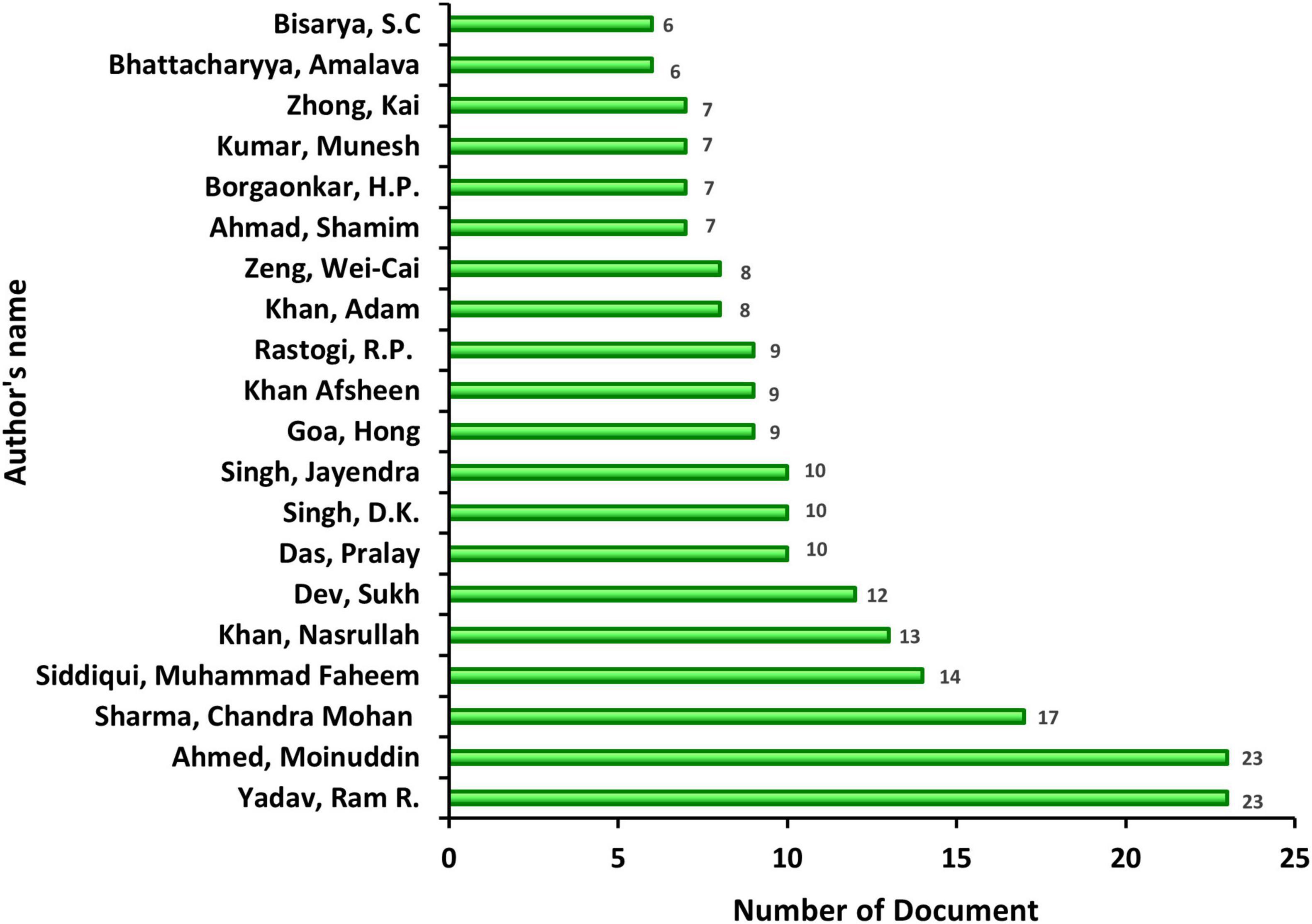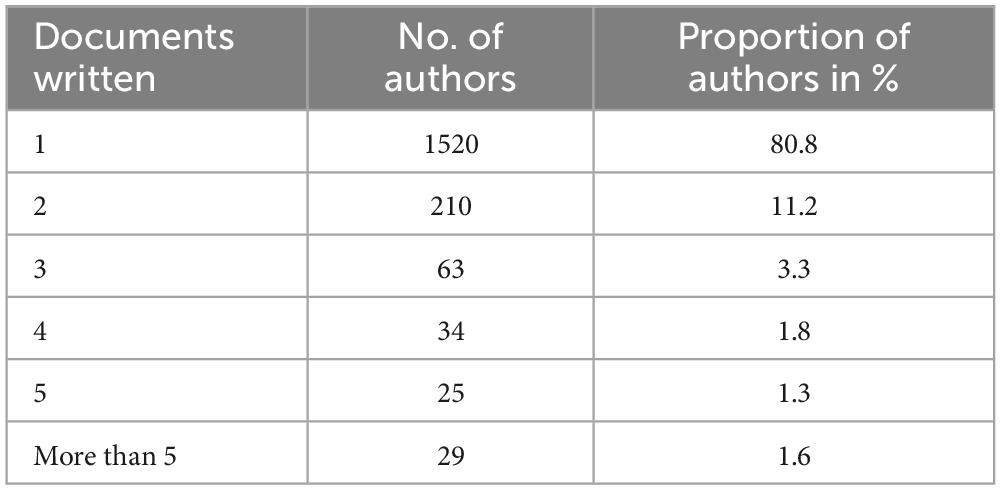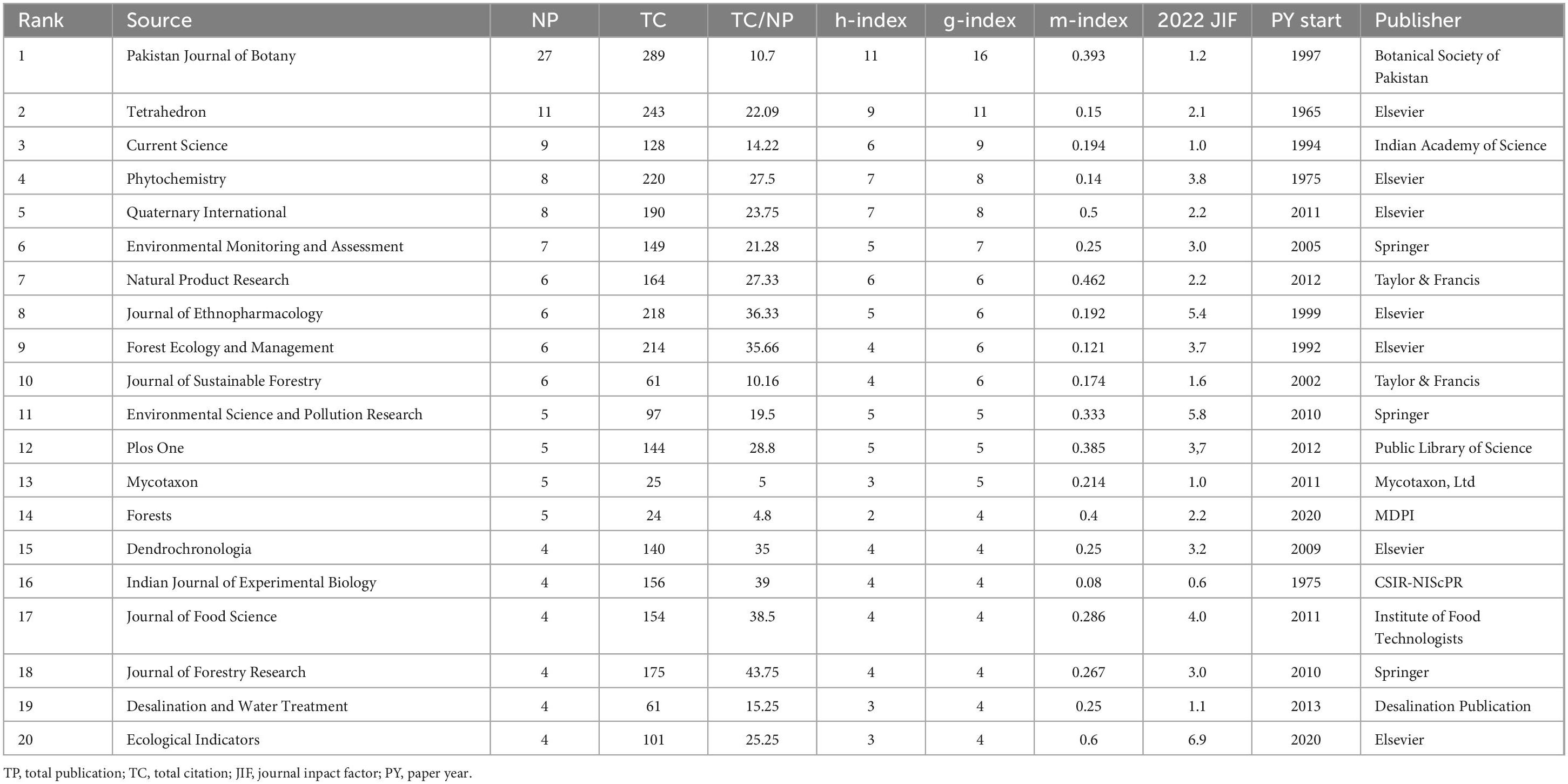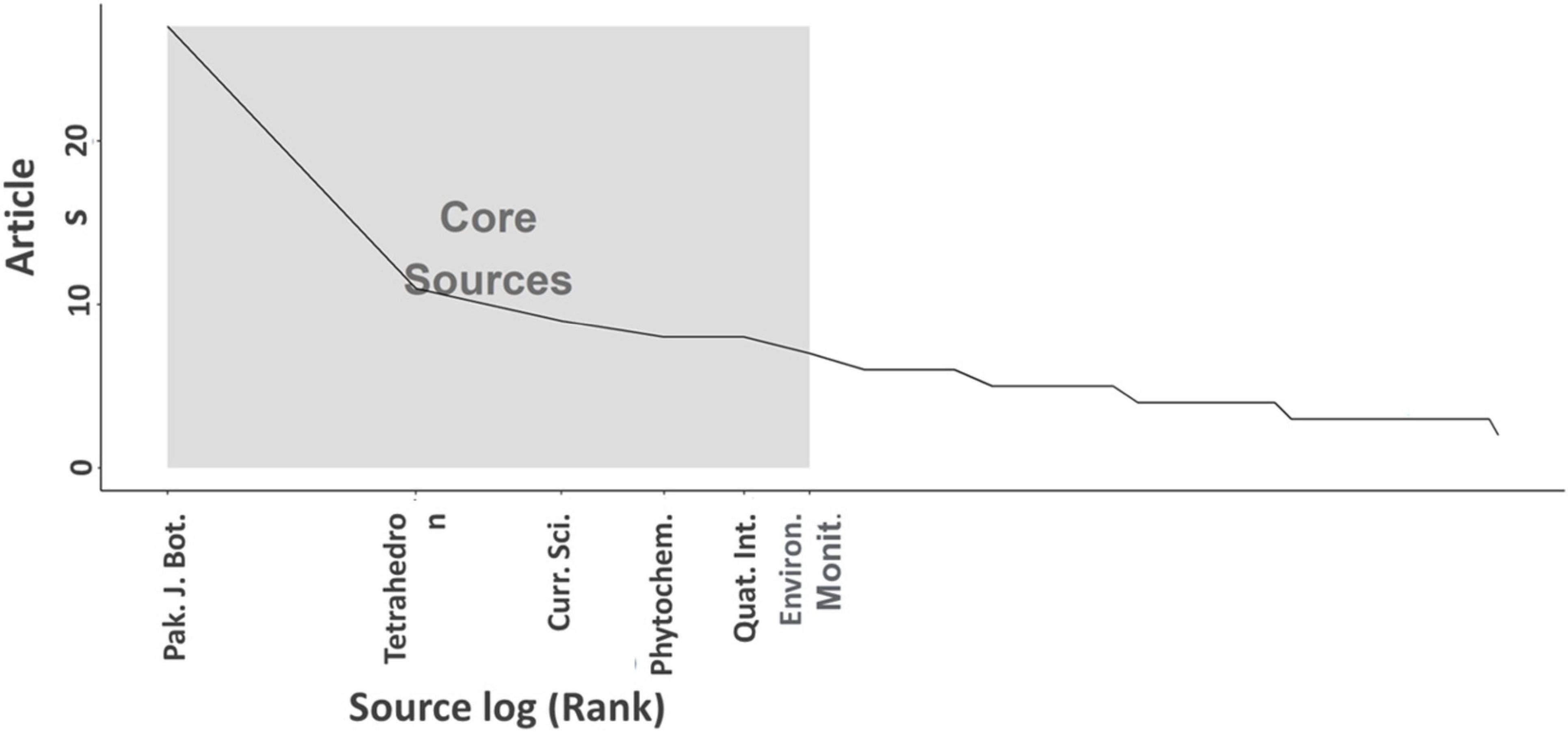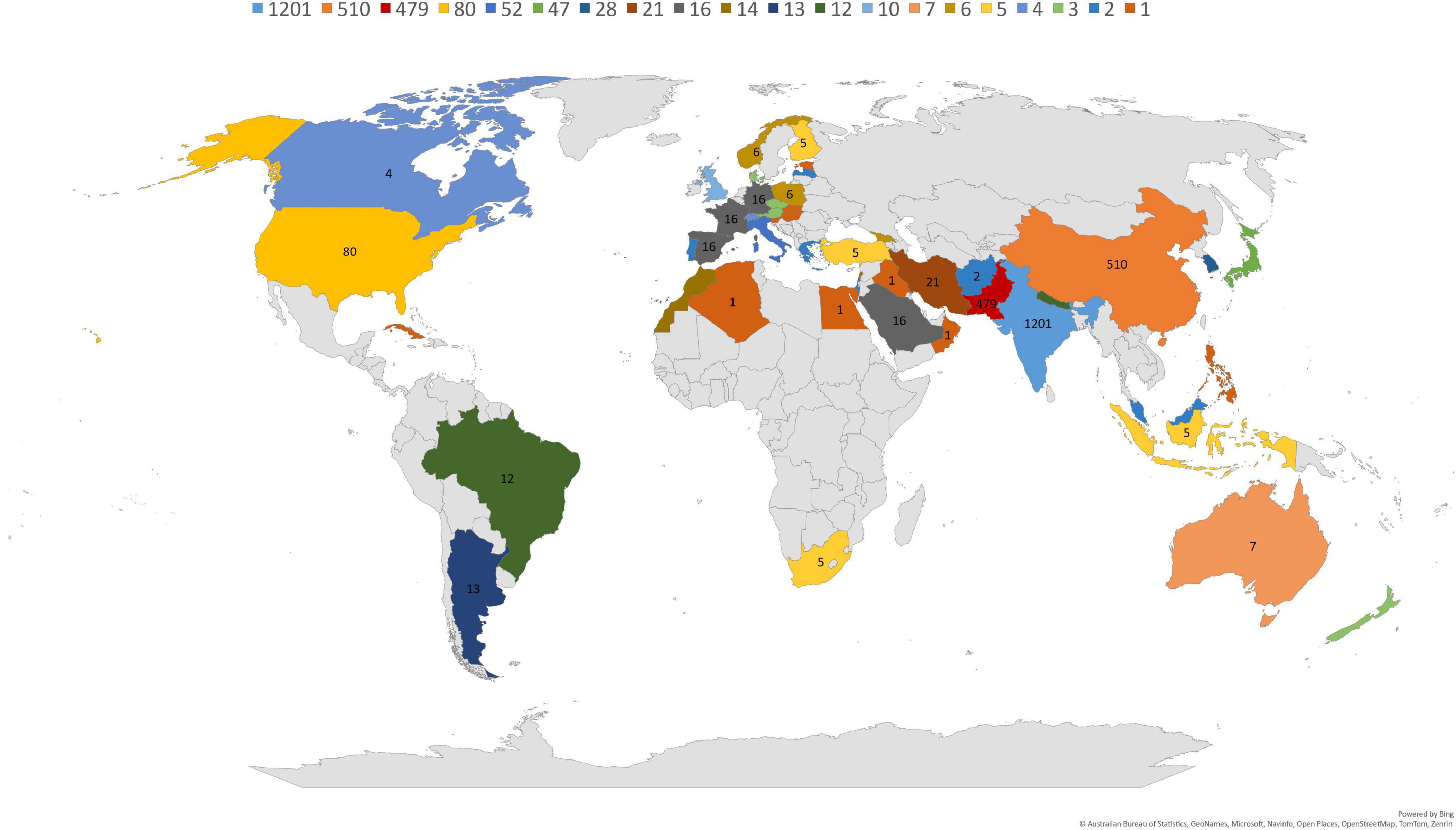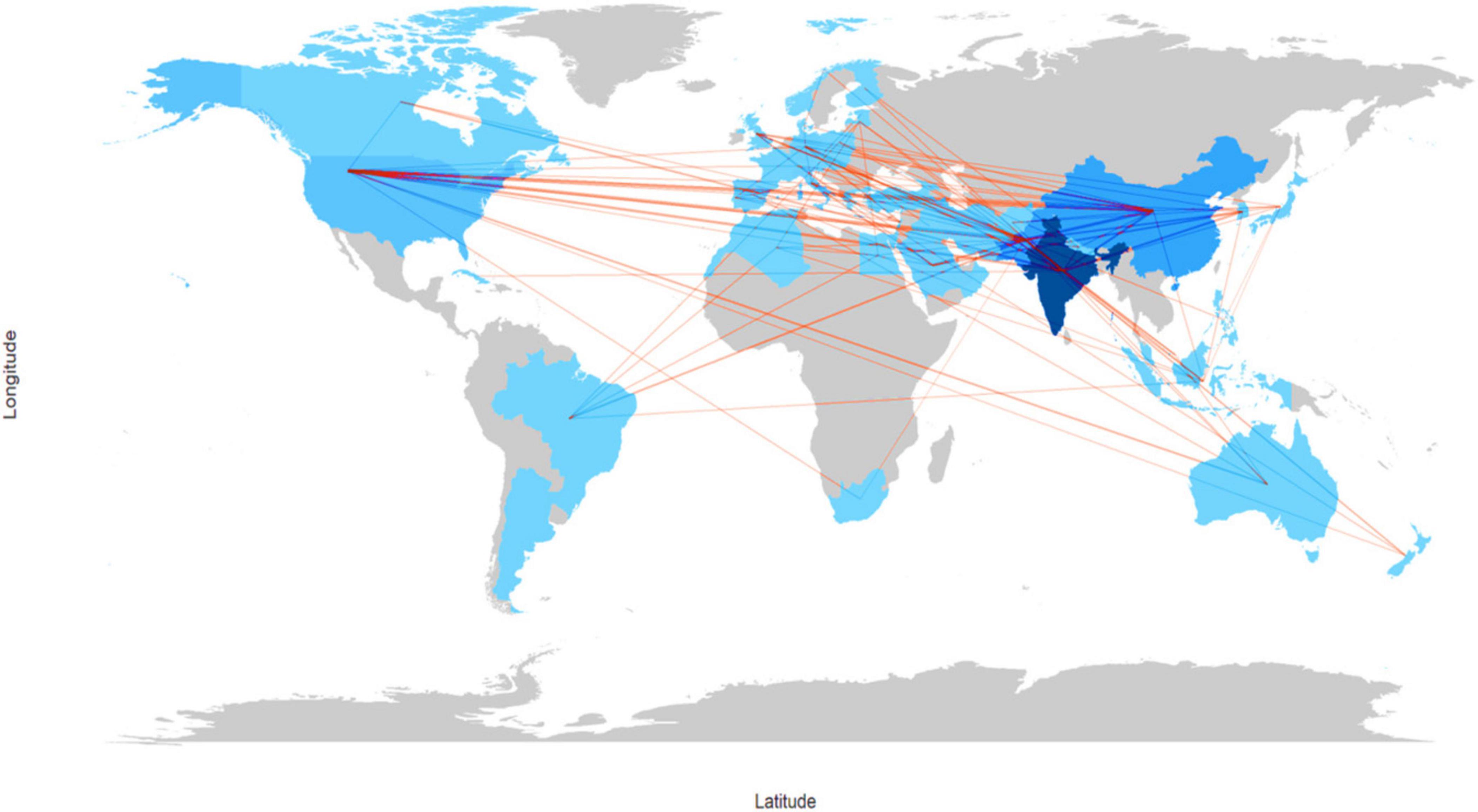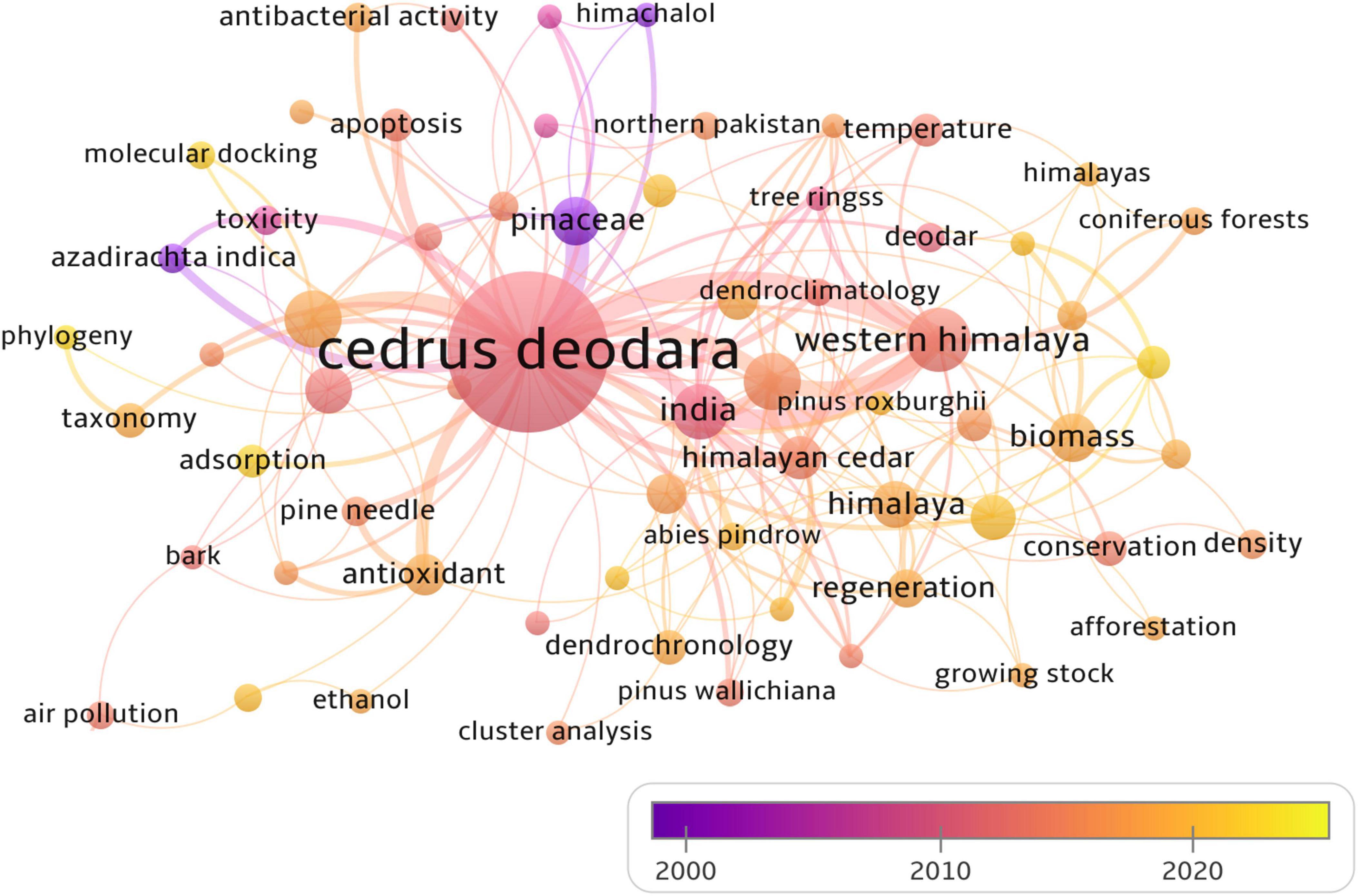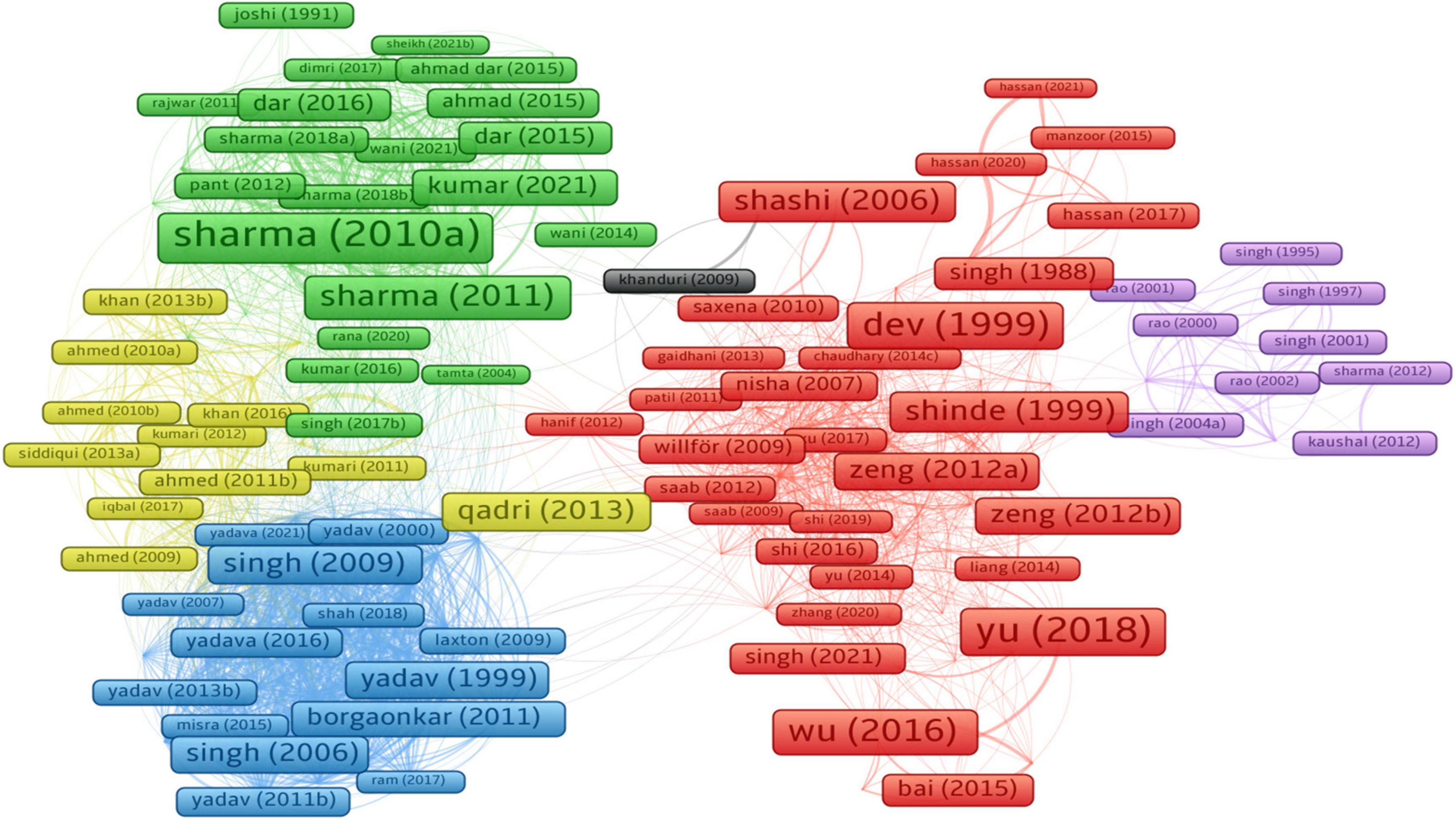- 1Centre for Biodiversity Conservation and Management, G.B. Pant National Institute of Himalayan Environment, Almora, Uttarakhand, India
- 2Forest Research Institute (FRI), Dehradun, Uttarakhand, India
Himalayan Cedar (Cedrus deodara), a member of the family Pinaceae is well-known for its ecological, economic, and cultural significance. It is native to the Western Himalayan region and listed as Least Concern in the IUCN list of threatened species. In the present study, a bibliometric analysis of more than a hundred years of research on C. deodara is carried out. Total 616 documents published from 1916 to 2024 were retrieved from the Scopus database and analyzed using biblioshiny and VoS viewer. A comprehensive overview of publication trends, country-wise publications, bibliographic coupling, citation analysis, keyword analysis, and collaborative research networks are presented. The research findings revealed that publications have increased significantly in recent decades and primarily multidisciplinary. Forest ecology, pharmacology, phytochemistry, climate change, environmental science, and taxonomy were among the major thrust areas. However, recent studies are mostly focused on carbon stock, biomass, dendrochronology, and climate change. Out of the 362 publication sources, Bradford’s law identified six journals as core sources for publication. Lotka’ law revealed that only 8% of authors have published more than two documents on C. deodara. The present study provides a comprehensive evaluation and visualization of C. deodara based bibliometric research carried out during the past 100 years. Further, the study provides collective information and a research framework for scholars, the general public, and decision-makers by identifying research gaps and future research areas.
1 Introduction
Cedrus deodara (Roxb. ex D. Don) G.Don, commonly known as the “Himalayan cedar,” usually forms pure forest stands along elevations ranging from 1200 to 3050 m asl. This Himalayan monotypic genus of the family Pinaceae is native to the Western Himalaya (Pandey et al., 2023) with extended distribution from Karakoram to Nepal, Bhutan, and the northeastern Indian Himalaya (Gupta et al., 2024). C. deodara forms a repository of sacred groves across the region (Singh et al., 2011) and functions as a keystone species. This, economically (Negi, 2022), medicinally (Bhat et al., 2021), and culturally important plant species (Bhatt et al., 2024), support various ecosystem services to the region (Gupta et al., 2023). Besides, it plays a key role in ecosystem functioning, carbon assimilation, and allows the advent of low-carbon settlements (Li et al., 2022). The research history of C. deodara indicates that various aspects of the species have been explored such as medicinal (Parvez and Anjum, 2024), ethnobotany (Dev, 1999; Bisht et al., 2021), phytochemistry (Adinarayana and Seshadri, 1965; Heinrich et al., 2021), and taxonomy (Lee et al., 2020). Furthermore, there has been increased attention in the twenty-first century on the role of C. deodara in climate change research and its ecological and environmental impact, including dendrochronology (Gupta et al., 2024).
It has been reported that C. deodara has the highest biomass and carbon sequestration potential among the Himalayan conifers (Sheikh et al., 2021; Kumar et al., 2024). However, the growth of this species has been significantly impacted by climate change (Dhyani et al., 2022) and other anthropogenic activities. Populations of C. deodara are decreasing under warming climate (Gilani et al., 2020), making it more vulnerable (Pandey et al., 2023). The species is classified among the endangered conifer species in the Western Himalayan region (Ginwal et al., 2020; Rana et al., 2020) and listed as Least Concern in the IUCN list of threatened species (IUCN, 2024). According to Bhattacharyya et al. (2023), the increasing global warming crisis will result in up to 38% decrease in the growth of the C. deodara population and is assessed as the highest conservation priority index (CPI) species by Rana et al. (2020). In current and future climate scenarios, due to climate change-driven shifting, this species is likely to migrate toward higher elevations (Durrani et al., 2024), and may compete with subalpine and timberline species.
Despite extensive research on C. deodara, there is a lack of a comprehensive systematic study of the literature. Nowadays, traditional evaluations of research documents are becoming less effective and more subjective due to their descriptive nature and the increasing amount of literature (Donthu et al., 2021a,b). In this context, it is important to compile, synthesize and analyze existing research information from multiple ways. Bibliometrics is a useful tool for analyzing huge quantities of information with reduced bias in the review process (Jiang et al., 2020). Bibliometrics is an important tool for obtaining qualitative and quantitative data on published content. It has been widely used in recent years to analyze the characteristics of various academic achievements and map topic knowledge in multiple domains (Yang et al., 2019; Paletto et al., 2020). Bibliometric studies allow researchers to evaluate the structure of current knowledge in an area and review its historical growth (Dharmani et al., 2021). It is also used to identify growing research trends, collaborative patterns, and research areas of greatest need, to characterize the macroscopic situation, provide information about the current study, and recommend future directions for research (Van Eck and Waltman, 2014; Wani et al., 2023; Bargali et al., 2024). In the present study, a fully automated bibliometric methodology that uses quantitative approaches to review documents available on C. deodara was followed. The present study aims to investigate performance analysis of field development and research trends for publications, authors, journals, thematic map, countries, citations, affiliations, keywords, and collaborative networks; to identify the areas of research for which C. deodara have been explored; and to find out future research directions on C. deodara. Thus, to gain insights into the current state of research and to identify research trends and gaps, present study was carried out. By examining the frequency and effect of citations, researchers can evaluate the effect of individual articles and the overall effect of research in the field. This information can be used to highlight areas that require more interdisciplinary research and collaboration and to identify promising avenues for future research.
2 Methodology
2.1 Data acquisition
Data was retrieved from the Scopus database,1 accessed on July 5, 2024. Scopus is one of the trusted online databases with over 2.4 billion documents covering 330 disciplines through more than 7,000 SCI-indexed international publishers and 99 % of the journals indexed in Web of Science are also indexed in Scopus (Singh et al., 2021; Bargali et al., 2024), and we focused our further research on the Scopus database. The search involved a comprehensive keyword search using Boolean logic ‘AND’ and “OR” with the strings “Cedrus AND deodara”, “Himalayan AND Cedar” to filter the documents. The initial search attempted to find these strings in any component (titles, abstracts, keywords) of peer-reviewed literature and acquired 722 documents. The search results were downloaded as a CSV file containing article information, including citation details, bibliographic information, abstracts, keywords, and other relevant data. These documents were subsequently evaluated using the Preferred Reporting Items for Systematic Reviews and Meta-Analyses (PRISMA) approach (Page et al., 2021; Bargali et al., 2024). We excluded 106 papers based on the following criteria: duplicate files (03), titles, keywords, and abstracts lacking information related to C. deodara (54), and documents not in the English language (49). Thus, a total of 616 documents were finally retrieved for further analysis (Figure 1).
2.2 Data analysis
The bibliometrics tool, developed through R programming language was used to conduct a macro-research and development review for C. deodara in the present study following Wani et al. (2023). Data were analyzed for publication trend, most relevant sources, authors, affiliations, and countries, country collaboration analysis, and keyword analysis.VOS viewer, a tool for constructing knowledge maps using network data and displaying bibliometric networks was also used for coupling and clustering. It is also used to analyze co-authorship and co-occurrence and create networks of authors, institutions, countries, and keywords (Van Eck and Waltman, 2014; Wani et al., 2024). Further, Microsoft Excel 2021 was used to prepare publication trends and country production maps.
3 Results and discussion
3.1 Main information and publication trend
A total of 616 academic documents have been published on “Cedrus deodara” between 1916 and July 2024. Out of 616 documents, there were 568 research publications, 23 conference papers, 17 review articles, and 8 book chapters with an average number of citations per document was 18.56. These documents were published by 1881 authors and the average number of co-authors per document was 4.34. The “authors per document” metric counts each author only once, even if they have written multiple documents. Therefore, the “Authors per Document” metric will always be less than or equal to the “Co-authors per Document” metric (Verma and Ghosh, 2024). The publication trend indicates that the first research paper on C. deodara was published in 1916 by Oswald Digby Rober entitled “Volatile Oil from the Wood of the Indian Deodar Tree.” However, the second research paper, entitled “Contribution to the life-history of C. deodara Loud: I. the development of the pollen grains,” was published after 20 years in 1936 by B. M. Johri of India. Similarly, the third research paper, titled “Thoughts on Yield Tables,” was published in 1959 by F. C. Osmaston of England. Thus, before the 1990s, the number of research documents was minimal and a continuous increase in the publication was observed thereafter. The highest number of research documents (44) on C. deodara were observed in the year 2024, which indicates the growing research interest of the scientific community in this species (Figure 2).
The publications on C. deodara have been categorized into 18 research fields. The ‘Forest ecology’ field ranked first, with 116 publications followed by ‘Pharmacology’ (86), ‘Phytochemistry’ (82), Climate Change (74), Environmental Science (53), Taxonomy (36), Wood Science (32), Entomology (32), Mycology (26), Ethnobotany (20), Biotechnology (18), and Plant Pathology (15). The analysis of these topics showed that research on C. deodara is multidisciplinary. By examining research topics, we discovered that Phytochemistry, Pharmacology, Ecology, Climate Change, and Environmental Science had a significant contribution on overall publication. The forest ecology research was mainly focused on carbon stock, biomass, biodiversity conservation, soil science, and forestry. Similarly, pharmacology focuses on major disciplines in therapeutics and other health sciences, while phytochemistry deals with chemical substances produced by plants. Climate change deals with dendrochronology, climate science, and plant physiology. Environmental science deals with the relationships between C. deodara and human activities. In the context of air pollution, the focus was on detecting, understanding, and assessing the impact of various pollutants on C. deodara growth. Limited documents focused on fields like wood science, entomology, mycology, plant pathology, bioenergy, immunology, and agriculture. As we discussed in the introductory section, how studies on phytochemistry, pharmacology, ethnobotany, and taxonomy had a well-established history. Over the past few decades, emerging disciplines such as forest ecology, climate change, genetics, wood science, environmental science, and mycology have been gradually gaining importance as areas of research. Furthermore, advancements have facilitated rapid progress in ecological studies on C. deodara. As previously mentioned, due to its significant carbon sequestration capacity, it is crucial to focus future research on the ecological aspects of C. deodara.
3.2 Most productive authors
The authorship analysis for this study revealed that a total of 1881 authors have significantly contributed to research papers on C. deodara. Among these, 21 were independent/single authors, while 1860 were collaborative/multi-authored. The most prolific authors include “Ram R. Yadav” from the Birbal Sahni Institute of Palaeobotany, India, and “Moinuddin Ahmed” from the University of Arts, Science and Technology, Pakistan, with 23 publications each, they were followed by Chandra Mohan Sharma (17 publications), Muhammad Faheem Siddiqui (14 publications), Nasrullah Khan (13 publications), Sukh Dev (12 publications), and Pralay Das, D.K. Singh and Jayendra Singh (10 publications each) (Figure 3). Lotka’s Inverse Square Law of scientific productivity explains how often authors publish on a specific topic. According to the law, the number of authors making ‘n’ contributions is roughly equal to ‘1/n’ of the number of authors producing only one contribution (Kumar and Mohindra, 2015). Lotka’s Law is used to analyze data for better understanding the co-authorship relationship, which is well-known in bibliometrics, as mentioned by Ahmi et al. (2020). Table 1 summarizes that there are 1520 (80.8%) authors who had published a single document on C. deodara, while 210 (11.2%) authors had published two documents, and 150 (8%) had published more than two documents. The most globally cited document on C. deodara was a study by Shinde et al. (1999), which explores the anti-inflammatory properties of volatile oil from C. deodara wood. The research shows that the oil can significantly reduce inflammation in rat models, particularly in stressful environments such as heat or hypotonic surroundings, by suppressing edema and lowering the breakdown of red blood cells. The oil’s effectiveness is attributed to its ability to protect cell membranes, thus reducing inflammation. This suggests that the oil could be used for therapeutic purposes in managing inflammatory disorders. The second most cited work, by Sharma et al. (2010), discussed the impact of forest conservation and afforestation on reducing climate change through increased carbon sequestration. The study emphasizes the significance of protecting old-growth forests, especially conifer-dominated forests like C. deodara (Moist Deodar Forest), in reducing CO2 emissions through their high carbon stocks and ongoing carbon storage. Additionally, it suggests that conserving existing forests with high carbon density may have a greater impact on carbon storage and climate change mitigation compared to afforestation. Another notable paper, published by Yu et al. (2018), aimed to improve soy protein-based films by enhancing their mechanical properties and moisture resistance while adding antioxidant activity. This was achieved by incorporating cellulose nanocrystals (CNCs) and C. deodara pine needle extract (PNE) into the films. The addition of CNCs enhanced mechanical strength and reduced moisture content, while PNE decreased water vapor permeability and added antioxidant characteristics, making the films more suitable for active food packaging. The top twenty most globally cited documents on C. deodara are presented in the Supplementary Table 1.
3.3 Most productive journals
The results indicate that the academic documents on C. deodara have been published in 362 sources. Among these sources, Pakistan Journal of Botany had the highest number (27) of publications, followed by Tetrahedron (11) and Current Science (9). The Pakistan Journal of Botany also has the highest total citation count i.e. 289 citations. Regarding total citation/total publication (TC/TP) values, the Journal of Forestry Research performed the best with a ratio of 43.75, followed by the Indian Journal of Experimental Biology (39). A detailed analysis of the top 20 journals is depicted in Table 2.
According to Bradford’s Law, a small number of journals containing a large number of articles on a specific topic is referred to as “core sources,” (Wani et al., 2023). In this study, a core source with an average citation of 10 was selected. Out of the total 362 sources, only six journals were identified as core sources (Figure 4). This indicates that these six journals viz. Pakistan Journal of Botany, Tetrahedron, Current Science, Phytochemistry, Quaternary International, and Environmental Monitoring and Assessment likely to contain a significant portion of the articles related to C. deodara, while the remaining sources may have fewer articles. Recent research on C. deodara has been published in high-quality journals focusing on multidisciplinary research, including environmental research. Based on the 2022 journal impact factor (JIF), “Ecological Indicators” had the highest impact factor (6.9), followed by “Environmental Science and Pollution Research” (5.8) and “Journal of Ethnopharmacology” (5.4).
3.4 Countries and affiliation productivity
Authors from 48 countries have contributed to the research on C. deodara (Figure 5). India had the highest number of publications (in terms of authors) on C. deodara with 1201 documents, followed by China with 510, Pakistan with 479, the United States with 80, Italy with 52, Japan with 47, and South Korea with 28. Authors from most of the other countries like Afghanistan, Greece, Israel, Latvia, Malaysia, and Portugal have 2 documents each. Algeria, Cuba, Egypt, Estonia, Hungary, Iraq, Oman, Philippines, Slovakia, and Slovenia have only one or two documents published. More than 10 documents were published by sub-continents like Asia, North and South America, and smaller parts of Europe and Africa. Sub-continents like Africa, Australia, and smaller parts of Europe have less than 10 documents. In conclusion, research interest in C. deodara is increasing in countries outside its native Asian subcontinent.
Based on our analysis, authors from 1297 organizations/institutions have published documents on C. deodara. Of these, only 92 met the minimum threshold of having at least 2 documents. In terms of maximum documents, the Birbal Sahni Institute of Palaeobotany in India took the lead with 24 documents followed by the University of Karachi and Sichuan University with 17 and 16 documents respectively. Notably, six of the top ten universities are based in India, two in China, and one each in Pakistan and the United States. The study found that the Birbal Sahni Institute of Palaeobotany had a considerable stake in C. deodara-based studies. The Bombay College of Pharmacy ranked first with a TC/TP ratio of 153.25, followed by Sichuan University (59.625) and the Birbal Sahni Institute of Palaeobotany (36.96). A detailed breakdown of the top 10 notable organizations is depicted in Supplementary Table 2. According to Ridwan et al. (2023), ranking allows for a precise comparison of academic institutions based on their global reach, frequency of publication in peer-reviewed journals, presence in prestigious journals within their field, and the distribution of their publications across high-caliber synthetic literature and scientific research. Additionally, increased funding and collaboration among researchers from various nations and fields of study will lead to a better understanding of research patterns related to C. deodara in response to current environmental challenges such as climate change.
3.5 Collaboration analysis
Research has increasingly emphasized collaboration as the primary driver for generating knowledge across academic fields. This shift toward collaborative research is evident across various academic disciplines. Collaborative research has led to higher citation rates, which have been steadily increasing over the time (Paphawasit and Wudhikarn, 2022). Figure 6 illustrates the countries that had conducted collaborative research on C. deodara. The blue color indicates countries that have published papers, with the color intensity corresponding to the number of publications. The brown lines represent the connections between the countries, and the thickness of the lines reflects the extent of collaboration. Pakistan has the highest collaboration with 21 countries, followed by India (15), China (12), and the USA (11). The collaboration patterns suggest that researchers from countries like India, Pakistan, China, and the USA have worked together to produce high-quality research. The research by Bhattacharyya et al. (2023) highlights the need of long-term research on C. deodara for understanding its global distribution, ecological patterns, and analyzing the implications of climate change, declining habitat, and other environmental stressors.
Top 10 countries with authors’ collaboration are illustrated in the Figure 7. India had the highest number of corresponding authors with 221 publications, accounting for 35.9% of the total, followed by China with 88 publications (14.3%), and Pakistan with 85 publications (13.8%),. India collaborated most frequently with authors from their own country, with 209 single-country publications (SCP) and 12 publications involving multiple countries (MCP). Meanwhile, Pakistan had the highest number of MCP with 24 publications. Japan and Germany had the lowest SCP with just 1 publication each, while Italy, Iran, Korea, and France had the lowest MCP with only 1 publication each.
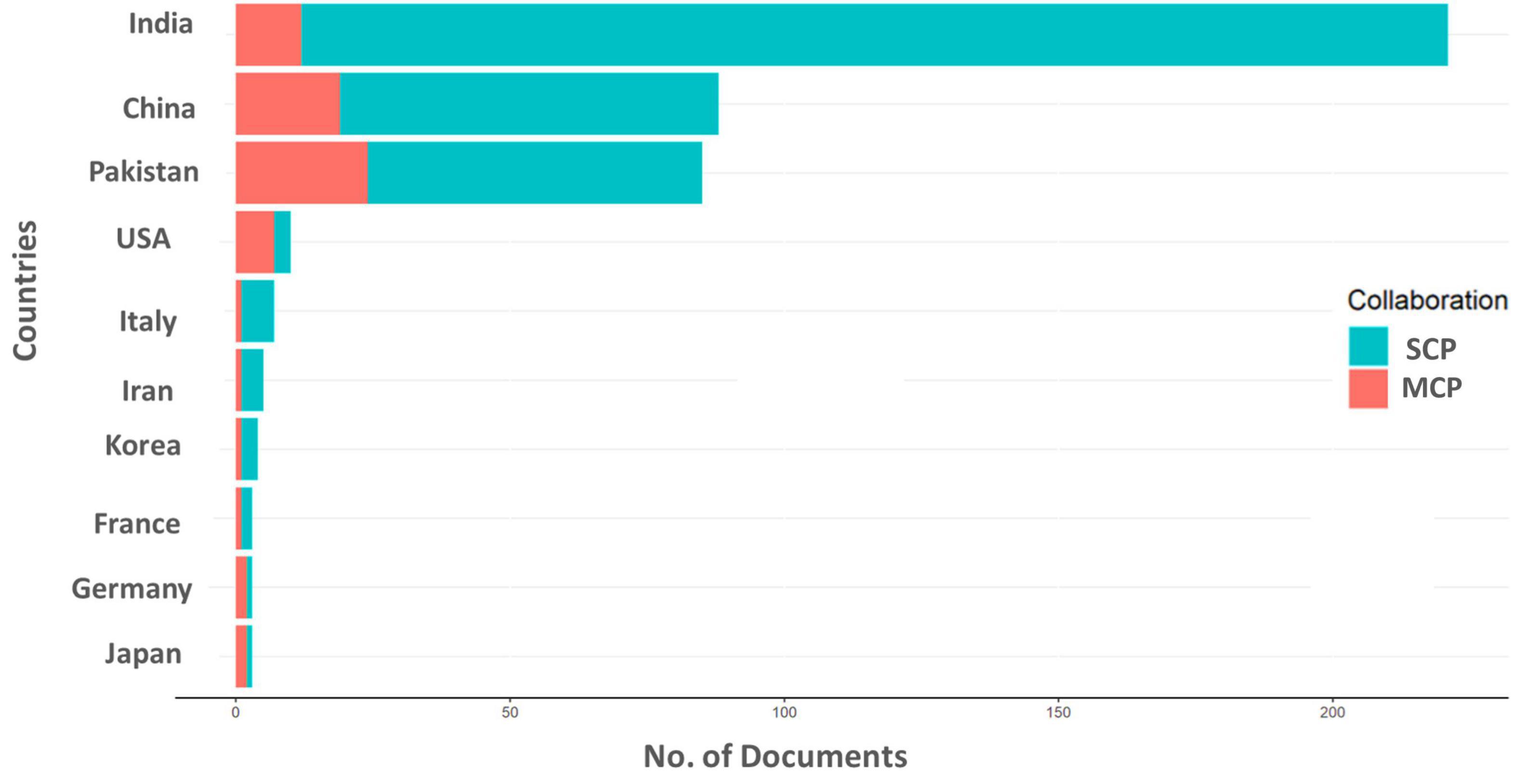
Figure 7. Top ten countries based on authors collaboration. SCP, single country production; MCP, multiple country production.
3.6 Keyword analysis
Overlay visualization analysis revealed that a total of 1746 keywords have been used. In the author keyword co-occurrence network (Figure 8), the size of the words represents the frequency of occurrence of author keywords, with the most frequent words being larger and more noticeable. The keyword “Cedrus deodara” appeared most frequently, 144 times, followed by “western Himalaya” (25 times), “tree rings” (20 times), “essential oil” (20 times), “India” (19 times), “Pinaceae” (15 times), “biomass” (15 times), “Himalaya” (14 times), “Cedrus” (14 times), “climate change” (13 times), “Himalayan cedar” (12 times), and “medicinal plant” (10 times). The results further revealed that the initial research on C. deodara was related to phytochemistry, ethnobotany, and pharmacological studies possibly due to its importance in traditional medicinal systems (Kalam et al., 2023). Over time, the focus shifted to topics related to dendroclimatology and climate change, and now the trend is moving toward research topics such as carbon sequestration, biomass, and carbon stock. C. deodara plays a significant role not only in ethnobotanical uses but also in trending issues such as climate change mitigation. Due to its high biomass and capacity for carbon sequestration potential, C. deodara contributes to forests under present pressure to mitigate climate change (Sheikh et al., 2021).
The strategic diagram of the thematic map constructed using the author’s keyword is depicted in Figure 9. The diagram divides all research themes into four sections based on two variables, centrality and density. The importance of external connections to other themes is represented by parameter centrality (x-axis), which shows how significant the issue is in the development of the researched area and how much a group interacts with other groups (Callon et al., 1991). The level of internal connections among all keywords is known as parameter density (y-axis), which measures the internal strength of the group and shows how the topic has progressed (Callon et al., 1991). The motor theme was both well-developed and essential for the advancement of the C. deodara based studies. Niche themes were highly developed internally but not extensively outside. The weak internal and external development of declining stage in declining theme. Although, basic themes are not fully developed, but these are fundamental and transversal themes significant for the research field. We identified the subject of each cluster in accordance with the thematic map and the specific details of each cluster, following Gao and Larjavaara (2024).
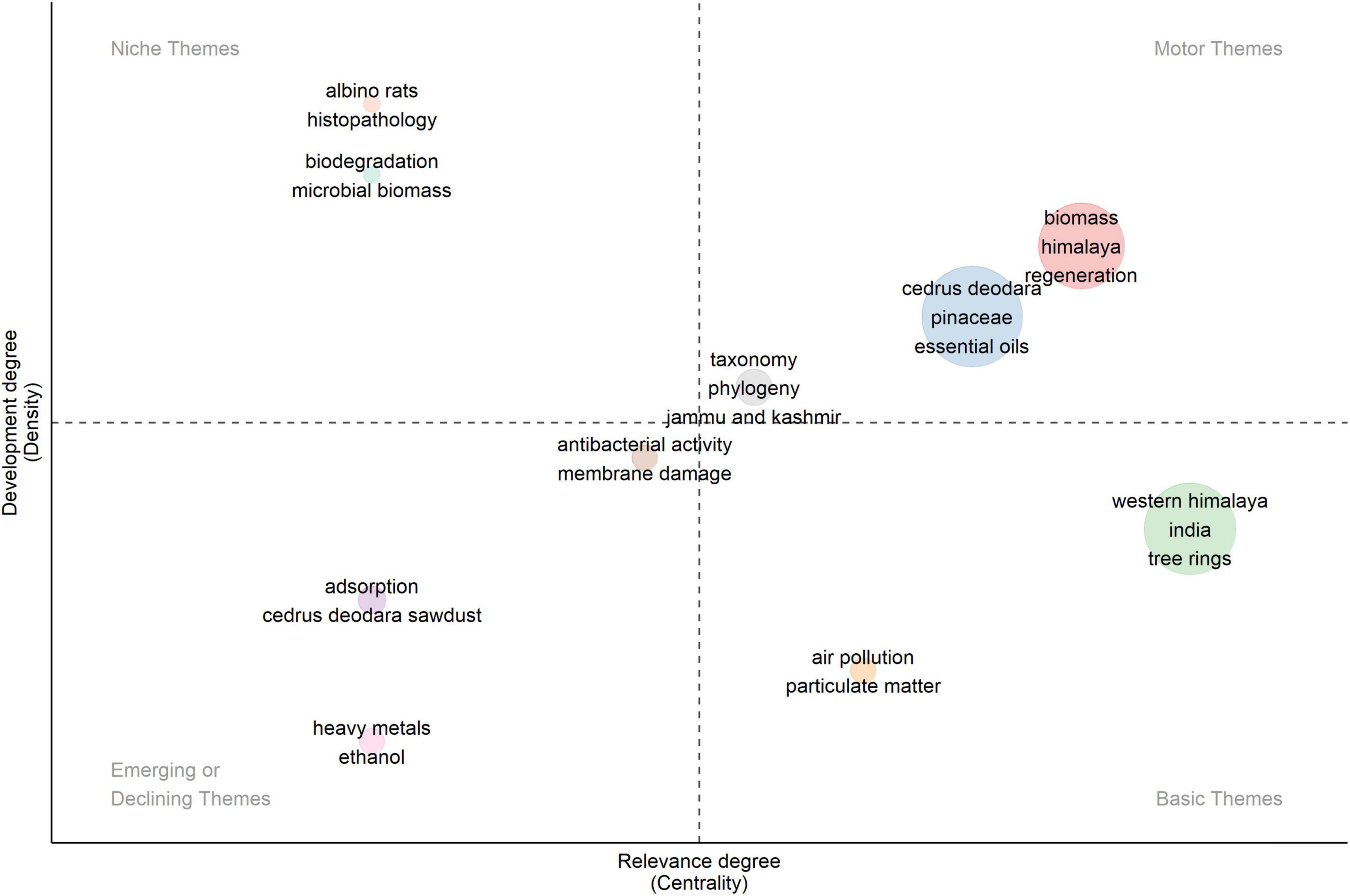
Figure 9. Thematic map showing the clustering of author keywords used in documents on Cedrus deodara.
3.7 Bibliographic coupling analysis
In the present study, out of 616 documents, 383 meet the requirement of having more than five citations. According to Kessler (1963), bibliographic coupling happens when two documents reference the same sources. The higher link strength value (8105) in this study, indicates that two academic works have shared a large number of references and considered as more intellectually related. The size and color of the frames in the map vary based on the number of common citations referenced in the chosen documents. Cluster analysis is used to identify groups of related items. In Figure 10, six clusters representing different dimensions of studies are depicted based on their subject relatedness. The largest cluster consists of 70 items (red nodes) with the highest citation of 155 by Yu et al. (2018) and this cluster covers the research area of biochemistry and pharmacology. The second cluster has 43 items (green nodes) with the highest citation of 42 by Sharma et al. (2010) and focuses on studies related to Carbon Stock and climate change. The third cluster contains 39 items (blue nodes) with the highest citation of 106 by Singh et al. (2009) and related to dendroclimatological studies. The fourth cluster has 21 items (yellow nodes) with a maximum citation of 97 by Qadri et al. (2013) and is related to mycology. The fifth cluster has 11 items (purple nodes) with Kaushal et al. (2012) receiving 21 citations. The smallest cluster consists of 3 items (black nodes) with the highest citation of 17 by Khanduri and Sharma (2009) and is related to Phenological studies on C. deodara.
4 Conclusions and future implications
A bibliometric analysis was conducted on 616 research documents on Cedrus deodara from 1916 to 2024 using Scopus database. The analysis revealed i) research on C. deodara has been increasingly popular in recent decades, particularly in Asian countries such as India, China, and Pakistan. ii) the Birbal Sahni Institute of Palaeobotany has the significant research influence at the institutional level, while the Pakistan Journal of Botany has published the most research on C. deodara. iii) author analysis and bibliographic coupling analysis showed majority of the authors working on C. deodara are from India and Pakistan, and having the higher level of international collaboration. iv) the research on C. deodara has become multidisciplinary in recent past, with focus on research fields such as forest ecology, pharmacology, phytochemistry, climate change, and environmental science. This multidisciplinary approach is expected to contribute toward improved research quality and highlight the unexplored potential of C. deodara. v) comprehensive study of the cooccurrence of author keywords indicates that recent research on C. deodara is focused on carbon sequestration, biomass, carbon stock, climate change research including dendrochronology, and regeneration potential of the species.
The research needs to consider potential adaptation and mitigation approaches that could impact the future of C. deodara forests. Based on the above findings, this study suggests three future research directions for C. deodara: i) Assessment of the factors contributing to the decline in stand productivity, regeneration and degradation using collaboration and emerging techniques such as dendroclimatology, vulnerability assessment etc. ii) Identify potential habitats for its future growth across the Hindu Kush Himalaya region. This can be achieved using new climatic distribution models developed by the Intergovernmental Panel on Climate Change (IPCC) for mapping and spatial modeling. iii) Text mining technologies could help future researchers to improve the extraction and analysis of complex bibliometric data. The study thoroughly examined different aspects of C. deodara research and created a macro-knowledge map using bibliometric approaches. Despite being based on vast datasets and automated technology, the bibliometric analysis struggles to detect textual complexities, which hinders our ability to capture precise terminologies. Similarly, due to the language barrier, mostly documents written in English language are used for data mining, however, documents written in other languages might contain crucial information.
Data availability statement
The original contributions presented in this study are included in this article/Supplementary material, further inquiries can be directed to the corresponding author.
Author contributions
AK: Data curation, Formal analysis, Methodology, Software, Writing – original draft, Writing – review and editing. AP: Conceptualization, Investigation, Methodology, Supervision, Visualization, Writing – original draft, Writing – review and editing.
Funding
The author(s) declare that no financial support was received for the research, authorship, and/or publication of this article.
Acknowledgments
We acknowledge the head Centre for Biodiversity Conservation and Management (CBCM) for his encouragement. The director G. B. Pant National Institute of Himalayan Environment (NIHE), Kosi-Katarmal, Almora is highly acknowledged for providing the necessary facilities.
Conflict of interest
The authors declare that the research was conducted in the absence of any commercial or financial relationships that could be construed as a potential conflict of interest.
Publisher’s note
All claims expressed in this article are solely those of the authors and do not necessarily represent those of their affiliated organizations, or those of the publisher, the editors and the reviewers. Any product that may be evaluated in this article, or claim that may be made by its manufacturer, is not guaranteed or endorsed by the publisher.
Supplementary material
The Supplementary Material for this article can be found online at: https://www.frontiersin.org/articles/10.3389/ffgc.2024.1485083/full#supplementary-material
Footnotes
References
Adinarayana, D., and Seshadri, T. R. (1965). Chemical investigation of the stem-bark of Cedrus deodara: Isolation of a new dihydroflavonol, deodarin. Tetrahedron 21, 3727–3730.
Ahmi, A., Saidin, S. Z., Mohd Nasir, M. H., and Ismail, Z. (2020). Applicability of Lotka’s law in eXtensible business reporting language (XBRL) studies. Int. J. Adv. Sci. Technol. 29, 282–289.
Bargali, H., Pandey, A., Bhatt, D., Sundriyal, R. C., and Uniyal, V. P. (2024). Forest fire management, funding dynamics, and research in the burning frontier: A comprehensive review. Trees Forests People 16:100526.
Bhat, M. N., Singh, B., Surmal, O., Singh, B., Shivgotra, V., and Musarella, C. M. (2021). Ethnobotany of the Himalayas: Safeguarding medical practices and traditional uses of Kashmir regions. Biology 10:851. doi: 10.3390/biology10090851
Bhatt, H., Jugran, H. P., and Pandey, R. (2024). Cultural ecosystem services nexus with socio-cultural attributes and traditional ecological knowledge for managing community forests of Indian western Himalaya. Ecol. Indic. 166:112379.
Bhattacharyya, A., Dhyani, R., Joshi, R., Shekhar, M., Kuniyal, J. C., Ranhotra, P. S., et al. (2023). Is survival of Himalayan Cedar (Cedrus deodara) threatened? An evaluation based on predicted scenarios of its growth trend under future climate change. Sci. Total Environ. 882:163630. doi: 10.1016/j.scitotenv.2023.163630
Bisht, A., Jain, S., Misra, A., Dwivedi, J., Paliwal, S., and Sharma, S. (2021). Cedrus deodara (Roxb. ex D. Don) G. Don: A review of traditional use, phytochemical composition and pharmacology. J. Ethnopharmacol. 279:114361. doi: 10.1016/j.jep.2021.114361
Callon, M., Courtial, J. P., and Laville, F. (1991). Co-word analysis as a tool for describing the network of interactions between basic and technological research: The case of polymer chemistry. Scientometrics 22, 155–205.
Dev, S. (1999). Ancient-modern concordance in Ayurvedic plants: Some examples. Environ. Health Perspect. 107, 783–789. doi: 10.1289/ehp.99107783
Dharmani, P., Das, S., and Prashar, S. (2021). A bibliometric analysis of creative industries: Current trends and future directions. J. Bus. Res. 135, 252–267.
Dhyani, R., Joshi, R., Ranhotra, P. S., Shekhar, M., and Bhattacharyya, A. (2022). Age dependent growth response of Cedrus deodara to climate change in temperate zone of Western Himalaya. Trees Forests People 8:100221.
Donthu, N., Kumar, S., Mukherjee, D., Pandey, N., and Lim, W. M. (2021a). How to conduct a bibliometric analysis: An overview and guidelines. J. Bus. Res. 133, 285–296.
Donthu, N., Kumar, S., Pandey, N., Pandey, N., and Mishra, A. (2021b). Mapping the electronic word-of-mouth (eWOM) research: A systematic review and bibliometric analysis. J. Bus. Res. 135, 758–773.
Durrani, M. A., Raza, R., Shakil, M., Sabir, S., and Danish, M. (2024). Tree species migration to north and expansion in their habitat under future climate: An analysis of eight tree species Khyber Pakhtunkhwa, Pakistan. J. Ecol. Environ. 48:10.
Gao, W., and Larjavaara, M. (2024). Wind disturbance in forests: A bibliometric analysis and systematic review. Forest Ecol. Manag. 564:122001.
Gilani, H., Goheer, M. A., Ahmad, H., and Hussain, K. (2020). Under predicted climate change: Distribution and ecological niche modelling of six native tree species in Gilgit-Baltistan, Pakistan. Ecol. Indic. 111:106049.
Ginwal, H. S., Sharma, R., Chauhan, P., Rai, K. C., and Barthwal, S. (2020). Chloroplast microsatellites reveal genetic diversity and population structure in natural populations of Himalayan Cedar ((Roxb.) G. Don) in India. SilvaeGenetica 69, 86–93.
Gupta, R., Garkoti, S. C., Borgaonkar, H. P., Pandey, U., Mishra, A., and Joshi, R. K. (2024). Dendrochronological studies in the western Himalaya: Opportunities, challenges and prospects. Trop. Ecol. 65, 161–178.
Gupta, S., Gwal, S., and Singh, S. (2023). Spatial characterization of forest ecosystem services and human-induced complexities in Himalayan biodiversity hotspot area. Environ. Monit. Assess. 195:1335. doi: 10.1007/s10661-023-11902-6
Heinrich, M., Jiang, H., Scotti, F., Booker, A., Walt, H., Weckerle, C., et al. (2021). Medicinal plants from the Himalayan region for potential novel antimicrobial and anti-inflammatory skin treatments. J.Pharm. Pharmacol. 73, 956–967.
IUCN (2024). Available online at: https://www.iucnredlist.org/search?query=Cedrus%20deodara&searchType=species (accessed on July 07, 2024).
Jiang, C., Bhat, C. R., and Lam, W. H. (2020). A bibliometric overview of transportation research part B: Methodological in the past forty years (1979–2019). Transport. Res. Part B Methodol. 138, 268–291.
Kalam, M. A., Aqeel, A., and Ahmad, W. (2023). Deodar (Cedrus deodara (roxb.) Loud.): Therapeutic uses and pharmacological studies-a review. Indian J. Unani Med. 16:1.
Kaushal, R., Sharma, N., and Tandon, D. (2012). Cellulase and xylanase production by co-culture of Aspergillus niger and Fusarium oxysporum utilizing forest waste. Turkish J. Biochem. 37, 35–41.
Khanduri, V. P., and Sharma, C. M. (2009). Cyclic pollen production in Cedrus deodara. Sex. Plant Reprod. 22, 53–61.
Kumar, A., and Mohindra, R. (2015). Bibliometric analysis on knowledge management research. Int. J. Inform. Disseminat. Technol. 5, 106–113.
Kumar, P., Kumar, A., Patil, M., Hussain, S., and Singh, A. N. (2024). Factors influencing tree biomass and carbon stock in the Western Himalayas, India. Front. Forests Glob. Change 6:1328694. doi: 10.3389/ffgc.2023.1328694
Lee, J., Lee, T., Seo, H. Y., Lee, M., Lee, S., Hong, K. J., et al. (2020). One new record of the genus Cinara Curtis, 1835 (Hemiptera: Aphididae: Lachninae) from Korea. J. Asia Pac. Biodivers. 13, 465–469.
Li, Q., Zhu, Y., and Zhu, Z. (2022). Calculation and optimization of the carbon sink benefits of green space plants in residential areas: A case study of Suojin Village in Nanjing. Sustainability 15:607.
Negi, G. C. S. (2022). Trees, forests and people: The Central Himalayan case of forest ecosystem services. Trees Forests People 8:100222.
Page, M. J., McKenzie, J. E., Bossuyt, P. M., Boutron, I., Hoffmann, T. C., Mulrow, C. D., et al. (2021). The PRISMA 2020 statement: An updated guideline for reporting systematic reviews. BMJ 372:n71.
Paletto, A., Biancolillo, I., Bersier, J., Keller, M., and Romagnoli, M. (2020). A literature review on forest bioeconomy with a bibliometric network analysis. J. Forest Sci. 66, 265–279.
Pandey, R., Rawat, M., Pathak, A., Mehta, D., Bala, N., Bhatt, I. D., et al. (2023). Identification of functional traits responsible for environmental vulnerability of Cedrus deodara in temperate forests of Western Himalaya. Ecol. Indic. 157:111302.
Paphawasit, B., and Wudhikarn, R. (2022). Investigating patterns of research collaboration and citations in science and technology: A case of Chiang Mai University. Admin. Sci. 12:71.
Parvez, N., and Anjum, N. (2024). Traditional Himalayan plants, their conventional knowledge to evidence-based assessment with special emphasis on alzheimer’s and Parkinson’s diseases: Medicinal plants for the management of neurodegenerative diseases. Boca Raton, FL: CRC Press, 49–63.
Qadri, M., Johri, S., Shah, B. A., Khajuria, A., Sidiq, T., Lattoo, S. K., et al. (2013). Identification and bioactive potential of endophytic fungi isolated from selected plants of the Western Himalayas. SpringerPlus 2, 1–14.
Rana, D., Kapoor, K. S., Samant, S. S., and Bhatt, A. (2020). Plant species conservation priority index for preparing management strategies: A case study from the Western Himalayas of India. Small Scale Forestry 19, 461–481.
Ridwan, Q., Wani, Z. A., Anjum, N., Bhat, J. A., Hanief, M., and Pant, S. (2023). Human-wildlife conflict: A bibliometric analysis during 1991–2023. Reg. Sustain. 4, 309–321.
Sharma, C. M., Baduni, N. P., Gairola, S., Ghildiyal, S. K., and Suyal, S. (2010). Tree diversity and carbon stocks of some major forest types of Garhwal Himalaya, India. For. Ecol. Manag. 260, 2170–2179.
Sheikh, M. A., Kumar, M., Todaria, N. P., Bhat, J. A., Kumar, A., and Pandey, R. (2021). Contribution of Cedrus deodara forests for climate mitigation along altitudinal gradient in Garhwal Himalaya, India. Mitigat. Adapt. Strat. Glob. Change 26, 1–19.
Shinde, U. A., Phadke, A. S., Nair, A. M., Mungantiwar, A. A., Dikshit, V. J., and Saraf, M. N. (1999). Membrane stabilizing activity—a possible mechanism of action for the anti-inflammatory activity of Cedrus deodara wood oil. Fitoterapia 70, 251–257.
Singh, H., Agnihotri, P., Pande, P. C., and Husain, T. (2011). Biodiversity conservation through a traditional beliefs system in Indian Himalaya: A case study from Nakuleshwar sacred grove. Environmentalist 31, 246–253.
Singh, J., Yadav, R. R., and Wilmking, M. (2009). A 694-year tree-ring based rainfall reconstruction from Himachal Pradesh, India. Clim. Dyn. 33, 1149–1158.
Singh, V. K., Singh, P., Karmakar, M., Leta, J., and Mayr, P. (2021). The journal coverage ofweb of science, scopus and dimensions: A comparative analysis. Scientometrics 126, 5113–5142. doi: 10.1007/s11192-021-03948-5
Van Eck, N. J., and Waltman, L. (2014). Visualizing bibliometric networks: Measuring scholarly impact. Cham: Springer, 285–320. doi: 10.1007/978-3-319-10377-8_13
Verma, P., and Ghosh, P. K. (2024). The economics of forest carbon sequestration: A bibliometric analysis. Environ. Dev. Sustain. 26, 2989–3019.
Wani, Z. A., Akhter, F., Ridwan, Q., Rawat, Y. S., Ahmad, Z., and Pant, S. (2023). A bibliometric analysis of studies on plant endemism during the period of 1991–2022. J. Zool. Botan. Gardens 4, 692–710.
Wani, Z. A., Pant, S., Bhat, J. A., Tariq, M., Siddiqui, S., and Alshaharni, M. O. (2024). Bibliometric analysis of studies on threat assessment and prioritization of species for conservation. Front. For. Glob. Change 7:1374120.
Yang, J., Cheng, C. X., Song, C. Q., Shen, S., and Ning, L-x (2019). Visual analysis of the evolution and focus in landslide research field. J. Mt. Sci. 16, 991–1004.
Keywords: Cedrus deodara, Himalaya, biblioshiny, Bradford index, Lotka law
Citation: Kumar A and Pandey A (2024) A bibliometric analysis of 100 years of research on Himalayan cedar: research trends, gaps, and future implications. Front. For. Glob. Change 7:1485083. doi: 10.3389/ffgc.2024.1485083
Received: 23 August 2024; Accepted: 02 October 2024;
Published: 22 October 2024.
Edited by:
Jahangeer A. Bhat, Fiji National University, FijiReviewed by:
Shreekar Pant, Baba Ghulam Shah Badshah University, IndiaJunaid Magray, University of Kashmir, India
Copyright © 2024 Kumar and Pandey. This is an open-access article distributed under the terms of the Creative Commons Attribution License (CC BY). The use, distribution or reproduction in other forums is permitted, provided the original author(s) and the copyright owner(s) are credited and that the original publication in this journal is cited, in accordance with accepted academic practice. No use, distribution or reproduction is permitted which does not comply with these terms.
*Correspondence: Aseesh Pandey, ZHJhc2Vlc2hwYW5kZXlAZ21haWwuY29t; YXNlZXNoLnBAZ2JwaWhlZC5uaWMuaW4=
 Ashutosh Kumar
Ashutosh Kumar Aseesh Pandey
Aseesh Pandey